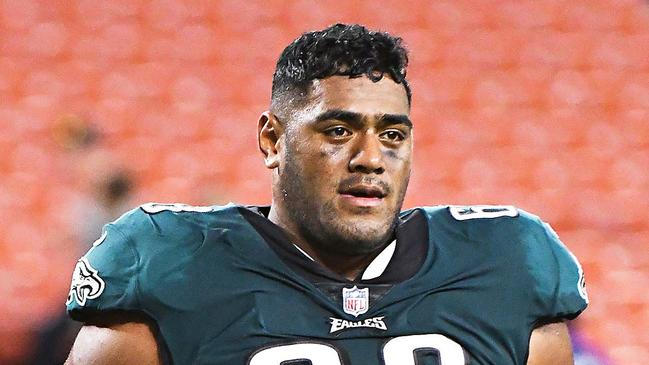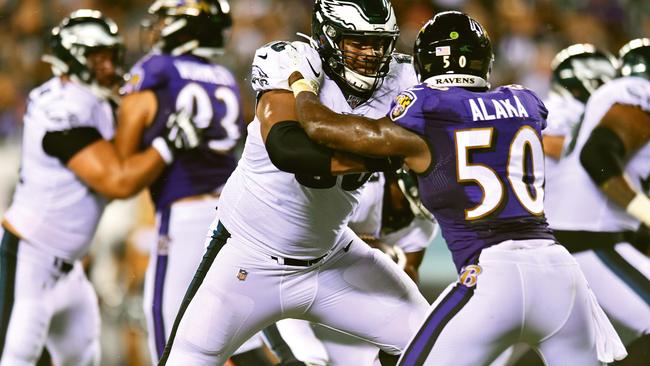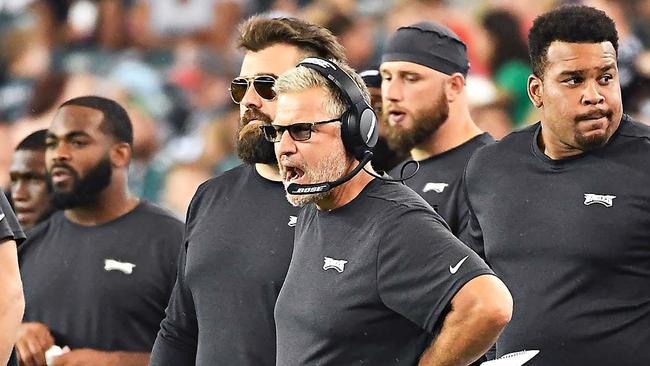Code breaker: Jordan Mailata, the ex-Rabbitoh taking on the NFL
His size and speed was a revelation to American football bosses. Now, could they teach Sydney’s Jordan Mailata how to play?

In February 2018 Jeff Stoutland, an assistant coach with the Philadelphia Eagles, was a day away from setting off on a golf trip when he got a call from the team’s scouting staff. They wanted him to go to Florida to check out a prospect, a guy almost no one had heard of, for the simple reason that he had never played a single down of American football. Stoutland, a barrel-chested man who has been coaching for 35 years, was not happy. He needed some time off, as did the rest of the team’s staff. The Eagles had just won the Super Bowl — a high moment, of course, but it meant they were still working five weeks after most of the rest of the NFL had gone on vacation.
A follow-up email included a link to Jordan Mailata competing in his sport at the time, rugby league, for the South Sydney Rabbitohs. Mailata could be seen either ploughing over would-be tacklers or causing them to bounce off him. Even though he’s 203cm tall and heavy-set, he looks surprisingly fast in the footage; the few players who manage to stay upright after engaging him struggle to catch up as he churns down the field.
Stoutland flew to Florida, where Mailata’s Australian agent had secured a spot for him at the NFL’s International Player Pathway program, a 12-week crash course in American football for athletes from outside the US. It takes place at the IMG Academy south of Tampa and seeks to identify potential NFL players, in part as a way to build international interest in a sport that is still played and watched almost exclusively by Americans. Some at the program have already played the game overseas. When Mailata arrived and was fitted for football gear, the equipment manager asked him how his helmet felt. “Honestly,” he answered, “I don’t know how it’s supposed to feel.”

The IMG coaches envisioned him as an offensive tackle, a blocker who clears lanes for running backs and, more importantly, protects high-value quarterbacks. His wingspan alone (90cm arms) promised to make him hard to get around. His performance in the tests given to offensive linemen — the 40-yard dash, shuttle runs and various agility drills that measure an athlete’s stamina, balance and ability to change direction — put him in the top ranks of the NFL’s offensive-tackle prospects in recent seasons. His body fat was below 20 per cent, exceedingly low for a man his size. “In my years of coaching, I probably haven’t had anybody who looks like that, top to bottom,” Jay Butler, a former NFL strength and conditioning coach who worked with Mailata at IMG, told ESPN.
Offensive tackle, though, is one of the most technically demanding positions in football. It requires size, complicated footwork, a high degree of intelligence and, usually, the acquired wisdom gained over years of high school and college competition needed to win the battles against defensive linemen who come charging across the line of scrimmage. One mistake can cost a team a game — or a season if the error results in a $30 million-a-year quarterback leaving the field injured.
As Stoutland, who is the Eagles’ offensive line coach, watched Mailata go through the drills — mainly simulations of pass blocking and run blocking — his scepticism evaporated. “Right away, I was like, ‘Hello!’” he recalls. “You better pay close attention here.” He was standing next to a scout for the Pittsburgh Steelers. “We were looking at each other, like, ‘Holy cow, what are we seeing here?’”
Less than two years later, Jordan Mailata has just begun his second season as an NFL player, following a year in which an ESPN writer named him the Eagles’ “most improved rookie” — even though he never set foot on the field last year in a regular-season game. But his performance during the 2018 pre-season had turned some former offensive linemen into cheerleaders. The buzz raised expectations and, if anything, increased the pressure on Mailata. Is he really a future star or just a curiosity piece? How soon until he is trusted to play in a game that counts? More broadly, how much football can you cram into an athlete, even one as big and outlandishly gifted as Mailata, if he has never played the sport before?

I met Mailata for the first time this northern spring, as he was preparing for the coming season. He had just finished working out at the Eagles’ training facility in Philadelphia. His tight black T-shirt emphasised his ripped chest and arm muscles. He has bulked up to 163kg. When we shook hands, mine disappeared — his hands are 28cm long from the tips of his fingers to the beginning of his wrists. Everything about him is extra large — his head; his face, which has more surface area than seems possible; his size-18 feet — but his frame is so large that he looks well proportioned. He just happens to be the size of two people. “We’re all pretty big, relatively speaking, but he’s probably the biggest human being I’ve ever seen,” says Stefen Wisniewski, a 190.5cm, 138kg offensive guard.
Mailata’s parents are of Samoan descent, and he is the fourth child of five, four of them boys. The family lives in Bankstown, Sydney. His father has worked as a handyman and a security guard; his mother cleaned hotel rooms. All his other siblings, he says, are “normal size” (though two brothers, at 190.5cm, would seem to challenge that claim).
From the time he was in his early teens, Mailata towered over just about everyone he encountered, and he grew used to being gawked at. His response has been to be approachable, jokey. After telling me that he graduated from high school while he was still 17, he added: “Don’t know how I did that. I’m not the smartest cookie in the jar,” even though his ability to quickly grasp an unfamiliar sport suggests otherwise.
At 22, Mailata is the third-youngest player on the Eagles’ roster and a consistently buoyant presence in a locker room where the two constants, as is true throughout pro football, are pressure and pain. Offensive linemen, in particular, pride themselves on playing through significant injuries, which are inevitable because they play in tight, crowded spaces. Few players dream of becoming offensive linemen, and it’s usually not the first position they have played. “You get moved there because you’re too fat or too slow,” Jason Kelce, the Eagles’ centre, told me. “That’s the most common route.”
Mailata had no expectations about what position he would play. Before he started at IMG, the only positions he could identify were the quarterbacks, running backs and “the guys who were always breaking through the line” — the defensive linemen, who are now his primary adversaries.

I wondered why Mailata chose football over rugby league, and he told me something that most people who have marvelled at the videos of him from Australia might find surprising: he didn’t have much of a future in rugby league. Mailata was not playing for the main Rabbitohs squad, but a team of prospects who were 20 years old and younger. His annual salary was just $8000 — in contrast to the $570,000 the Eagles are paying him this season. He had another job: working on a demolition crew.
Mailata’s coaches told him he would have to lose weight to advance to the Rabbitohs’ first team. “It’s a free-flow game with barely any stoppage,” he says, explaining their rationale. “They thought I couldn’t keep up. I didn’t agree — I was down to 310 [140kg], and they wanted me to lose 30 more pounds [13.6kg]. I already had hardly any body fat, so it was an option where I’d either have to starve myself or chop off a leg. I talked to my agency, and they said, ‘Why don’t you play a sport that appreciates your size?’”
Mailata, at the time, had not even watched much American football, but he had seen a lot of movies about the game, which he was eager to share with me. “‘Left side! Strong side!’” he suddenly blurted during one of our conversations. “That’s what Julius always says to Gerry,” he said, referring to Remember the Titans. “I don’t know why, but that always stuck in my head.”
He tried out a scene from another movie: “‘Where were you taking him, Mike?’” “‘To the bus — it was time for him to go home.’” I looked at him quizzically. “C’mon, man,” he said. “You have to know that one! That’s The Blind Side.”
Mailata usually watched one football game a year, the Super Bowl, which in Sydney is broadcast live at 10.30 on a Monday morning. His sharpest memory was of Super Bowl 50, because it featured Beyoncé, Bruno Mars and Coldplay at halftime. “I didn’t understand the sport, but I was just blown away by the level of the entertainment.”

On a scorching morning in July, Mailata was with his teammates on one of the practice fields as Stoutland put them through their “reps”. They were practising pass blocking — coming out of their crouched stances and back-pedalling quickly. “Good angles!” Stoutland shouted, his hands behind his back, chest jutted forward. “Get width!”
Mailata and the others took big gulps from the water bottles they were handed during breaks, then took off their helmets and just squirted the water over their heads. At these moments, and also in between plays, when they were scrimmaging against their teammates on defence, Mailata was almost always in conversation with the veteran offensive linemen. Frequently, they had their hands on his shoulders or hips and were turning him slightly in one direction or another — or mimicking foot movements for an upcoming play or one just completed. Were it not for their helmets and shoulder pads, you could imagine they were instructing him in ballroom dancing.
Mailata has had to learn not just the physical movements but also many dozens of offensive plays, as well as what to do when blocking assignments are suddenly changed at the line of scrimmage. His studies take place largely in what is referred to as “the room” — each position group on an NFL team has its own area. In the Eagles’ offensive-line room, the players sit in office chairs in front of a big screen as Stoutland presides over film critiques and fires questions at players, a process he refers to as “cold calling”. “I’m telling you, it’s stressful,” Mailata says. “It goes like: ‘Mailata! What are you going to do when this happens?’ You have to have no excuses. You get the wrong answer, and your arse is going to get chewed.”
Mailata was drafted to be a left tackle — the position made famous by the author Michael Lewis in The Blind Side. The title of the book and subsequent movie is a reference to the left tackle’s key role in protecting a right-handed quarterback’s blind side, where he can’t see pass rushers as he plants his left foot forward, cocks his arm and sets up to throw a pass. The Eagles’ starter at the position when Mailata was drafted was Jason Peters, now 37, a perennial All-Pro who is widely considered certain to be elected to the Pro Football Hall of Fame after he retires. He’s still holding down the position.
Peters was on and off the field with injuries last season, and late in the year Mailata believed he would soon get his chance. “Not many people know this, but my playing time was close,” he says. He was getting “double reps” with the scout team, which runs the upcoming opponent’s plays at practice, and the first team. But in December a stress fracture was diagnosed in his back, ending his season.
This summer, Mailata was practising at right tackle. In the 2019 draft, the Eagles selected a highly regarded left tackle in the first round, Andre Dillard, who played four seasons of college football at Washington State. The selection was not a comment on Mailata’s potential, exactly, but it may have reflected some prudence by team executives.
Mailata struggled at first after switching sides. He had to do everything in the opposite direction: he had his right rather than left hand on the ground in his three-point stance and was kicking his right foot back on pass protection. In one practice, he got beaten repeatedly by Joe Ostman, a smaller, quicker defensive lineman who kept spinning past him on his inside shoulder. It gnawed at him. “I just [expletive] hate it when I have a bad rep,” he said after he walked off the field.
But Mailata grew more comfortable on the right side and played almost every offensive play of the Eagles’ first three pre-season games this summer. In one notable moment, he single-handedly caved in an entire side of the Baltimore Ravens’ defensive line, leaving a hole big enough for the Eagles’ team bus to drive through.
Offensive linemen are allowed to use their hands, just not to grab onto opponents, which (if they’re caught) results in a holding penalty. They extend their arms quickly and violently, which they call punching. Brian Baldinger, another retired offensive lineman turned broadcaster, has praised Mailata’s “violent hands”.
“When they took him in the draft, I was like, ‘OK, they drafted King Kong, but the game’s too complex and that’s too complex a position’,” Baldinger told me. “He may learn some techniques, but there’s no way he can stand up to the real-time demands of a game. But he does. He played 250 snaps this summer, and he had four bad ones. He moves people off the line of scrimmage. His hands are really good. He has a very consistent pass set. He’ll have to wait a little bit to play, because the Eagles have such a strong offensive line, but I can tell you he’d be starting for several other NFL teams right now.”
It would probably be good for the NFL — the business of the NFL — for Mailata to succeed. Far fewer American boys are playing youth and high school football because of well-founded concerns among parents about concussions. The three other major American team sports — basketball, baseball and hockey — draw from international talent pipelines. Football does not, yet, but there may come a time soon when it has to.
Mailata was “beloved” at the IMG academy during the pathway program, one staff member told me. He gamely travelled the campus on a bicycle that was many sizes too small. He laughed along with everyone else when he tried to drink Gatorade without taking his helmet off and it all squirted down his jersey. “A special athlete and a special person,” Taryn Morgan, IMG Academy’s director of athletic and personal development, told me. “You love him for his big personality, but he also put the work in.”
Mailata’s teammates do not mistake his fun-loving manner for a lack of seriousness. It sometimes seems to mask his anxiety. He’s eager to prove he belongs. “I always feel like I’m not living up to expectations, but Coach Stout says don’t worry about expectations. Just improve every day.”
The New York Times

To join the conversation, please log in. Don't have an account? Register
Join the conversation, you are commenting as Logout